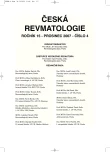Plasma cells as a marker predicting the outcome of anti-TNF therapy
Authors:
Š. Růžičková 1,3; Z. Cimburek 2; K. Jarošová 1; Š. Forejtová 1; J. Vencovský 1
Authors‘ workplace:
Revmatologický ústav, Praha, 2Sektor imunologie a gnotobiologie, Mikrobiologický ústav AV ČR, Praha
1; Biotechnologický sektor, Ústav molekulární genetiky AV ČR, Praha
3
Published in:
Čes. Revmatol., 15, 2007, No. 4, p. 179-184.
Category:
Original Papers
Overview
The aim of the study was to identify cell population which could be used as a marker predicting response to anti-TNF therapy. A total of 46 patients was analyzed, out of them: 23 patients with juvenile idiopatic arthritis (11 – Enbrel, 11 – Remicade and 1 – Humira), 16 patients with ankylosing spondylitis (8 – Enbrel, 8 – Remicade), 5 patients with rheumatoid arthritis (all Enbrel) and 2 patients with psoriatic arthritis (both Enbrel) and 19 controls. Clinical parameters (CRP, ESR, DAS28, BASDAI, VAS score, number of tender and swollen joints) from 11 patients with juvenile idiopatic arthritis and 3 with ankylosing spondylitis were available before and 3 months after onset of the therapy. Immunophenotyping of peripheral blood of patients and controls was performed using polychromatic flow cytometry. A population of CD19⁺CD20⁻CD27highCD38⁺CD138⁺ plasma cells was identified which significantly differed in the frequencies between responding and resistent patients (responders: 1.3–10.3%; median 7.04±1.05; 95%CI 4.06–9.03 vs. non-responders 17.3–37.3; median 27.75±9.18; 95%CI 18.12–37.38; p=0.0007). All responders showed statistically significant improvement of clinical parameters. The frequency of CD19⁺CD20⁻CD27highCD38⁺CD138⁺ plasma cell population was found to be in responders at least 13-fold reduced in comparison to non-responders and this population might represent biological marker predicting the outcome of anti-TNF therapy.
Key words:
anti-TNF, B-cells, plasma cells, flow cytometry, response to therapy
Sources
1. Nawroth PP, Bank I, Handley D, Cassimeris J, Chess L, Stern D. Tumor necrosis factor/cachectin interacts with endothelial cell receptors to induce release of inteleukin 1. J Exp Med 1986; 163 : 1363-1375.
2. Hawroth C, Brennan FM, Chantry D, Turner M, Maini RN, Feldman M. Expression of granulocyte-macrophage colony-stimulating factor in rheumatoid arthritis regulation by tumor necrosis factor alpha. Eur J Immunol 1991; 21 : 2575–2579.
3. Keffer J, Probert L, Cazlaris H, et al. Transgenic mice expressing human tumor necrosis factor: a predictive model of arthritis. EMBO 1991; 10 : 4025–4031.
4. Anti-tumor necrosis factor ameliorates joint disease in murine collagen-induced arthritis. Proc Natl Acad Sci U S A 1992; 89 : 9784–9788.
5. Feldman M, Elliot MJ, Woody JN, Maini RN. Anti - tumor necrosis factor-alpha therapy of rheumatoid arthritis. Adv Immunol 1997; 64 : 283–350.
6. Hommes DW, van Deventer SJ. Targeting tumor necrosis factor-alpha in inflammatory bowel disease: why, how, and when? Curr Opin Gastroenterol 2003; 19 : 350–357.
7. Felmann M, Brennan FM, Foxwell BMJ, Taylor PC, Williams RO. Anti-TNF therapy: Where have we got to in 2005? J Autoimmunity 2005; 25 : 26–27.
8. Petty RE, Southwood TR, Baum J, et al. Revision of the proposed classification criteria for juvenile idiopathic arthritis: Durban, 1997. Rheumatol 1998 25 : 1991–1994.
9. Moll JMH. New Criteria for the Diagnosis of Ankylosing Spondylitis. Scand J Rheumatology 1987; 65(Suppl): 12–24.
10. Arnett FC, Edworthy SM, Bloch DA, et al. The American Rheumatism Association 1987 Revised criteria for the classification of rheumatoid arthritis. Arthritis Rheum 1988; 31 : 315–324.
11. Růžičková Š, Niederlová J, Kryštůfková O, Vencovský J. Role B lymfocytů v patogenezi revmatoidní artritidy I. Subpopulace synoviálních B lymfocytů diferenciálně produkujících IgM a IgG mRNA. Rheumatológia 2005; 19 : 73–79.
12. Vigna-Perez M, Abud-Mendoza C, Portillo-Salazar H, et al. Immune effects of therapy with Adalimumab in patients with rheumatoid arthritis. Clin Exp Immunol 2005; 141 : 372–380.
13. Shen C, Maerten P, Geboes K, Van Assche G, Rutgeerts P, Ceuppens JL. Infliximab induces apoptosis of monocytes and T lymphocytes in a human-mouse chimeric model. Clin Immunol 2005; 115 : 250–259.
14. Danese S, Sans M, Scaldaferri F, et al. TNF-alpha blockade down-regulates the CD40/CD40L pathway in the mucosal microcirculation: a novel anti-inflammatory mechanism of infliximab in Crohn’s disease. J Immunol 2006; 176 : 2617–2624.
15. Catrina AI, Trollmo C, af Klint E, et al. Evidence that anti-tumor necrosis factor therapy with both etanercept and infliximab induces apoptosis in macrophages, but not lymphocytes, in rheumatoid arthritis joints: extended report. Arthritis Rheum 2005; 52 : 61–72.
16. Jacobi AM, Odendahl M, Reiter K, et al. Correlation between circulating CD27high plasma cells and disease activity in patients with systemic lupus erythematosus. Arthritis Rheum 2003; 48 : 1332–1342.
Labels
Dermatology & STDs Paediatric rheumatology RheumatologyArticle was published in
Czech Rheumatology

2007 Issue 4
Most read in this issue
- Rhabdomyolysis, a brief case report and commentary
- Hip joint destruction and secondary synovial chondromatosis in a patient with rheumatoid arthritis
- Musculoskeletal manifestations in celiac disease
- Procalcitonin in the diagnosis of bacterial infection in patients with autoimmune rheumatic diseases
